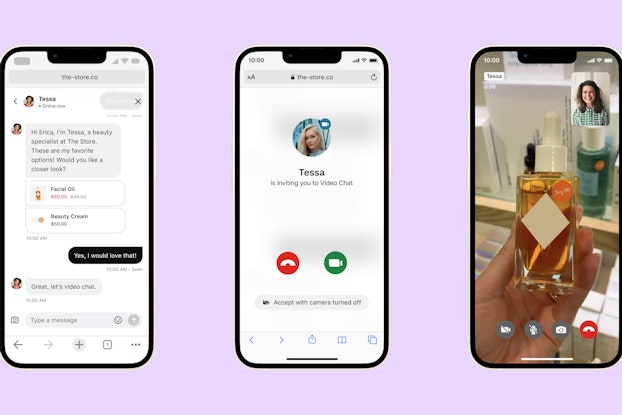
Why it matters:
- A survey of consumers found that 64% said not being able to see products up close was their top complaint about online shopping, and 72% said they would be more likely to buy if they could interact with a product expert, store associate, or other trusted person.
- Against that backdrop, Klarna’s 400,000 retail partners can now use the buy now, pay later payment platform’s new virtual shopping tool to connect store associates and product experts with online shoppers.
- The tool makes it possible for independent stores, direct-to-consumer brands, and influencers, as well as big retailers, to interact directly with their customers via two-way video chats and product demonstrations.
The buy now, pay later payment platform Klarna has unveiled a virtual shopping tool it believes will usher in a new era of e-commerce.
The tool lets retailers, both large and small, connect online shoppers with store associates and product experts through video and chat interactions designed to mimic in-person shopping. Employees at a store can participate in a two-way video chat with a customer, and demonstrate products using videos or photos through an app provided by Klarna.
Klarna, like competitors Afterpay and Affirm, lets customers pay for online goods in installments.
Klarna rolled the new feature out to its 400,000 retail partners in mid-May, and the company expects it will dramatically change consumer expectations for online shopping, Klarna Chief Marketing Officer David Sandstrom told CO-.
“The first wave of e-commerce was all about convenience,” Sandstrom told CO—. “The next wave of e-commerce is going to be about experiences and social interaction.”
[Read: Fintech Startups Update the Layaway Concept With Buy-Now-Pay-Later Payment Options]
The quest to boost online shopping conversion rates via live interactions
Amazon, Walmart, and social media giants TikTok, Instagram, and Pinterest are all racing to figure out the best way to combine social media, videos, and e-commerce, and Klarna, with its July 2021 acquisition of social shopping platform HERO, is no exception.
More than 300 brands and retailers, including Levi’s and Hugo Boss, were already using HERO, a tech platform that enables in-store associates to communicate with online customers, when Klarna acquired it. Those retailers have seen that having a live interaction with a store associate can boost conversion rates – the number of customers who complete a purchase after browsing – by as much as 1,000%, Sandstrom said.
This is a fantastic tool for smaller businesses that have one store, but that have an expertise [in a product category]. We also see newer online brands using this technology to serve people as if they had a store.
David Sandstrom, Chief Marketing Officer, Klarna
How it works: Connecting shoppers with store associates and product experts virtually
When an online consumer requests Klarna’s virtual shopping tool, store employees and product experts use an app provided by Klarna that enables them to have interactive chats and share photos and videos.
Klarna retail partners who want to use virtual shopping can add it for a one-time setup fee that varies based on the size of the business. There are no per-transaction fees or additional costs beyond the one-time fee.
Someone shopping on an e-commerce site of a Klarna partner that has added the feature will see a pop-up question on the site asking if they would like assistance.
In the case of a large retailer with multiple locations, the virtual shopping algorithm will connect the shopper with the appropriate employee at the nearest store location.
The demand for online shopping with a (live) human touch: Not offering it is like leaving a store unstaffed
Hero last year surveyed consumers and found that while most preferred online shopping, they said they missed the benefits of the in-person store experience, particularly being able to see products up close, and in three dimensions.
Sixty-four percent said not being able to see products in real life was their biggest complaint about online shopping, and 72% said a product expert, store associate, or friend would be most likely to influence their purchase decision.
The lack of personalization and human contact in e-commerce is a big reason online sales have plateaued at roughly 20% of retail, Sandstrom said.
By not providing a personalized experience on their e-commerce sites, retailers in effect are leaving a large store unstaffed, he said.
“It is the equivalent of having a flagship store on Times Square with loads of footfall and no one there greeting anyone,” Sandstrom said. “No one’s saying, ‘Hi, how can I help you?’”
The potential uses: Helping independent shops extend their brand expertise and geographic reach
In addition to connecting customers with salespeople at large retail chains, the tool will enable independent stores to establish themselves as product experts and grow their online sales beyond their geographic reach.
Direct-to-consumer brands can also use the video interactions to sell from a dark store (online pickup and delivery-only hubs) or replicate an in-person shopping experience in a video studio. Influencers could use it to sell products from their homes.
“This is a fantastic tool for smaller businesses that have one store, but that have an expertise [in a product category],” Sandstrom said. “We also see newer online brands using this technology to serve people as if they had a store,” he said.
[Read: Klarna Bets on 'Buy Now, Pay Later' as Key Element of Small Businesses' Post-Pandemic Recovery]
Why Klarna made this move: e-commerce is convenient, but it’s ‘very lonely and transactional’
By adding tools like virtual shopping, Klarna is continuing its strategy of moving beyond being a payments partner to becoming a growth partner for merchants, Sandstrom said.
Klarna was founded 16 years ago to solve what then was the biggest pain point connected with online commerce – collecting and processing payments, he said. Now, he said, the need to humanize and personalize the online experience is a major pain point for sellers and consumers.
“E-commerce is fantastically convenient, but it’s very lonely, it’s very boring, it’s very transactional, very unemotional,” he said.
Klarna’s aim with virtual shopping, he said, is to give consumers the ability to see, to ask questions, to talk with someone.
“We’ve been talking about omnichannel in the last couple of years,” he said. “This really is omnichannel – replicating the offline experience online.”
CO— aims to bring you inspiration from leading respected experts. However, before making any business decision, you should consult a professional who can advise you based on your individual situation.
Follow us on Instagram for more expert tips & business owners’ stories.
CO—is committed to helping you start, run and grow your small business. Learn more about the benefits of small business membership in the U.S. Chamber of Commerce, here.
CO— Exclusives: Insider Strategies
How the buzziest brands and hottest startups are solving today's biggest business challenges. CO— brings you advice from startup founders and top executives for thriving in a new world.








